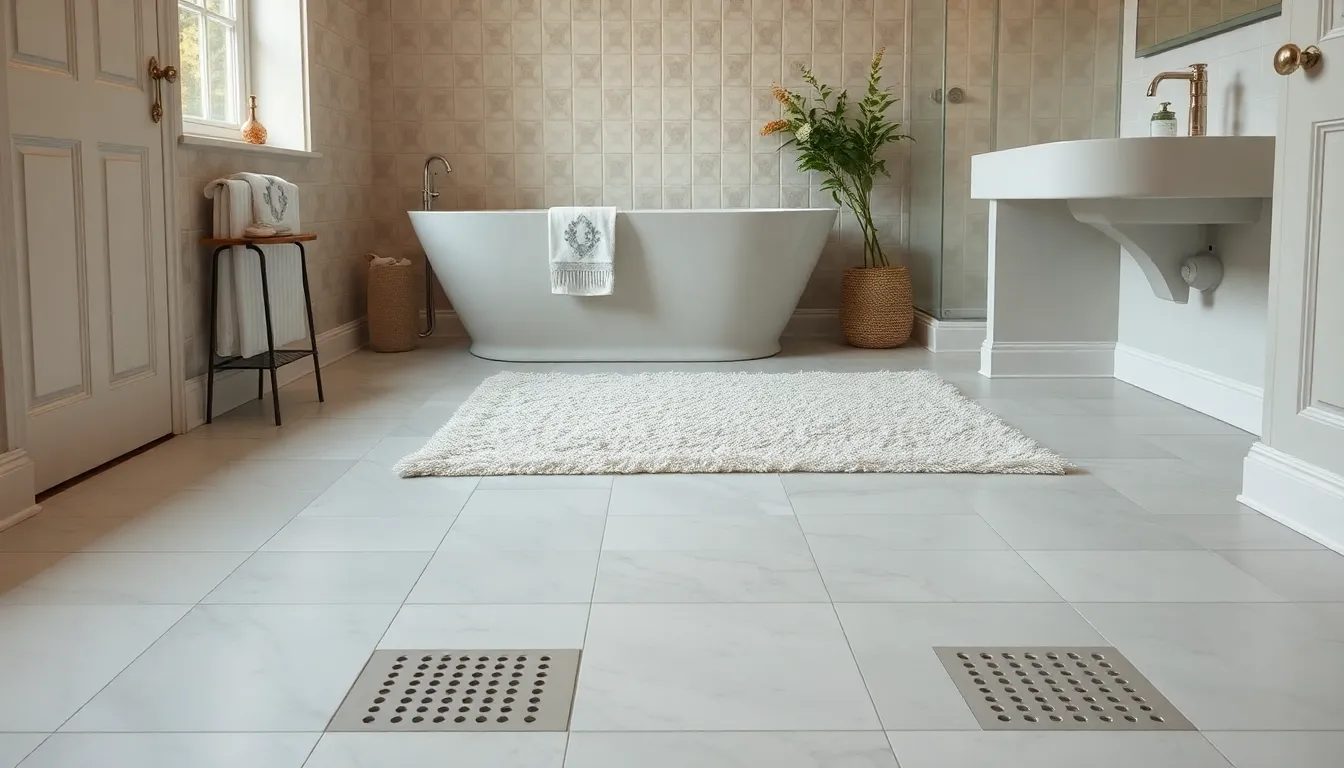Table of Contents
ToggleImagine stepping out of bed on a chilly morning and feeling the gentle warmth of heated floors beneath your feet. It’s like a cozy hug that says, “Welcome to the day!” Heated flooring isn’t just a luxury; it’s a game changer for anyone tired of cold toes and drafty rooms.
Overview of Heated Flooring
Heated flooring utilizes either electric or hydronic systems to warm indoor spaces. These systems distribute heat evenly across the floor, providing comfort throughout rooms. Various materials, including tile and laminate, are suitable for installation, enhancing the heating effect.
Electric systems function with heating cables or mats installed under the floor covering. These setups offer quick heat, often controlled by a programmable thermostat. Installation becomes feasible in existing homes and new constructions alike.
Hydronic systems circulate warm water through pipes beneath the floor. While installation costs may be higher, they provide efficient heating for larger areas. They work well in homes with existing boiler systems.
Efficiency remains a significant advantage of heated flooring. Comfort levels rise, particularly in bathrooms and kitchens, where cold tiles can be uncomfortable. Some studies indicate energy savings of up to 30% when compared to traditional heating methods.
Flexibility stands as another key benefit. Homeowners can select zones to heat individually, allowing for personalized comfort levels. This zoning can lead to increased energy savings, as different rooms can maintain varying temperatures based on usage.
Safety plays a crucial role in the appeal of heated flooring. Systems operate at low temperatures, reducing the risk of burns. Additionally, heated floors provide dry surfaces, which diminishes slip hazards during winter.
Overall, heated flooring transforms living spaces by combining functionality with luxury. It fits various design aesthetics and complements modern homes effectively. Many homeowners view heated flooring as a valuable investment that enhances comfort and increases property value.
Types of Heated Flooring

Heated flooring systems primarily fall into two categories: electric and hydronic. Each type offers unique benefits tailored to different needs.
Electric Heated Flooring
Electric heated flooring relies on heating cables or mats installed directly beneath the floor surface. It works well in small spaces such as bathrooms and kitchens, providing quick warmth whenever needed. Programmable thermostats control these systems, allowing users to set schedules for increased energy efficiency. Additionally, installation occurs easily in both new constructions and remodels, making it versatile for various setups. Maintenance generally proves minimal, as these systems typically last for many years without significant issues.
Hydronic Heated Flooring
Hydronic heated flooring circulates warm water through pipes located under the floor. This system efficiently warms larger areas due to the continuous flow of heated water. It integrates seamlessly with existing boiler systems, minimizing additional expenses. Operating at lower energy demands, it often results in cost savings compared to electric versions. Installation requires more complex plumbing work, making professional help essential. In larger homes, hydronic systems enable effective zone heating, ensuring consistent comfort across various spaces.
Benefits of Heated Flooring
Heated flooring offers several advantages that enhance the overall living experience. Comfort stands at the forefront, especially during chilly mornings.
Improved Comfort
Warmth underfoot creates a cozy atmosphere that elevates relaxation levels in any room. Stepping onto a heated floor provides immediate relief from cold surfaces, enhancing everyday activities like getting out of bed or cooking. These systems distribute heat evenly, reducing cold spots and ensuring consistent warmth throughout the space. Many homeowners report a drastic improvement in comfort while enjoying activities such as lounging or working from home. With its ability to warm entire areas, heated flooring transforms even the coldest corners into inviting spaces.
Energy Efficiency
Energy savings become a significant benefit of installing heated flooring. Compared to traditional heating methods, these systems can yield energy reductions of up to 30%. They operate efficiently by targeting specific zones, allowing users to warm only occupied areas. Electric and hydronic systems both provide excellent insulation, minimizing heat loss and optimizing energy use. With lower energy consumption, homeowners can enjoy reduced utility bills while keeping their homes comfortable. Making the switch to heated flooring represents a cost-effective long-term investment that pays off through enhanced efficiency.
Installation Process
Heated flooring installation requires careful planning and expertise to ensure optimal performance and efficiency.
Planning and Preparation
Planning for heated flooring starts with assessing space requirements. Homeowners should consider whether to choose electric or hydronic systems based on area size and heating needs. Evaluating insulation quality also plays a key role in the overall effectiveness of the flooring. Properly insulating the underfloor helps maximize heat retention, leading to cost savings. Creating a detailed layout is crucial, including the placement of electric mats or hydronic pipes to ensure even heat distribution. Finally, obtaining necessary permits or approvals can streamline the installation process, avoiding potential setbacks.
Professional vs. DIY Installation
Deciding between professional installation and DIY options involves weighing costs and complexity. Professional installers bring expertise and can handle the intricacies of hydronic systems more effectively. Hiring experienced technicians can minimize risks associated with improper installation, particularly when dealing with plumbing or electrical systems. On the other hand, DIY installation can be a cost-effective choice for homeowners comfortable with basic home improvement tasks. Those opting for DIY should follow manufacturer guidelines and ensure local building codes are met. Evaluating individual skills and resources helps determine the most suitable approach for a successful installation.
Maintenance and Care
Maintaining heated flooring is essential for ensuring its longevity and optimal performance. Regularly inspecting the system helps identify potential issues early. Check for any signs of wear or damage on the electric cables or hydronic pipes.
Cleaning the surface of heated floors should incorporate gentle methods. Use a damp mop with a mild cleaning solution to avoid harsh chemicals that could damage the system. Avoid using steam cleaners, as excessive moisture can cause problems for the underlying heating components.
Monitoring the thermostat settings aids in maintaining energy efficiency. Setting the thermostat to a lower temperature when the room is unoccupied can lead to further energy conservation. Consider scheduling regular temperature checks to confirm consistent heating throughout the space.
Professional maintenance services can provide thorough inspections and troubleshoot any issues with the system. Scheduling an annual checkup ensures that the electric or hydronic systems remain in top condition. Properly trained technicians know how to address specific concerns and can extend the lifespan of the heating system.
Lastly, homeowners should educate themselves on the system’s specifications. Understanding the warranty coverage helps in making informed decisions on repairs or replacements. Being aware of common troubleshooting steps allows for quick resolutions to minor problems.
Implementing these maintenance routines creates a comfortable home environment while maximizing efficiency. Balancing care and usability ensures that heated flooring remains a valued investment.
Heated flooring stands out as an exceptional choice for enhancing home comfort. Its ability to provide warmth underfoot transforms chilly spaces into inviting environments. With options like electric and hydronic systems homeowners can select the best fit for their needs and preferences.
The energy efficiency and targeted heating capabilities contribute to significant savings on utility bills. Regular maintenance ensures these systems continue to perform optimally while prolonging their lifespan.
Ultimately heated flooring not only elevates comfort but also adds value to a home making it a worthwhile investment for any homeowner looking to improve their living space.







